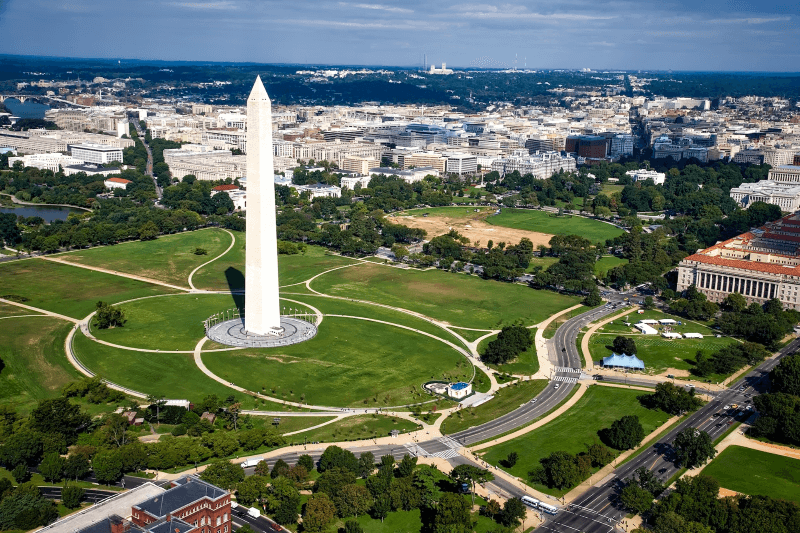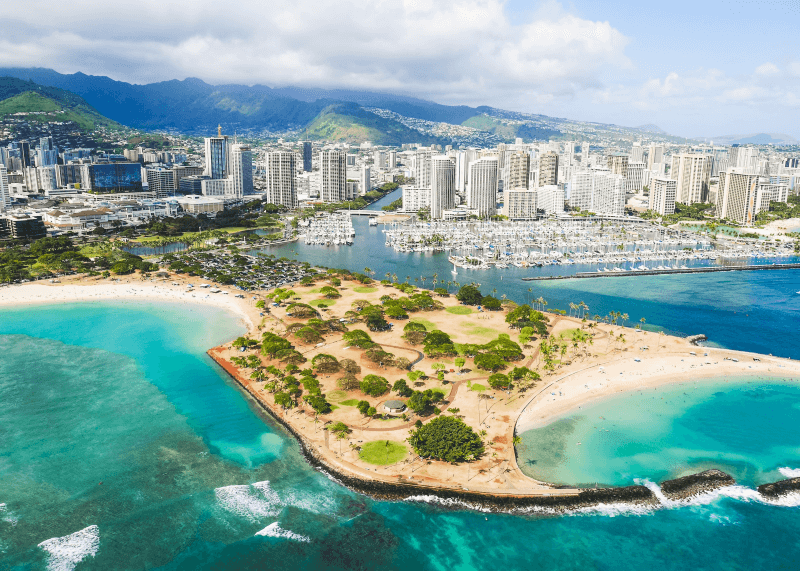
In a country where the car is king of the road, which cities are the best for living without a set of wheels?
With over one-third of Americans eager to abandon their automobiles and new car-free neighborhoods to meet the demand, HVAC Gnome ranked 2024’s Best Cities for Car-Free Living.
We compared the 200 biggest U.S. cities based on 4 categories. We looked at each city’s walkability, bikeability, transit ridership, and pedestrian safety, among 23 total metrics.
Stroll through our ranking below. To learn how we ranked the cities, see our methodology.
Contents
Rankings
See how each city fared in our ranking:
Top 5 Close Up
Check out the slideshow below for highlights on each of our top five cities.
The Upshot
Dense, walkable cities like San Francisco (No. 1), Boston (No. 2), and New York (No. 3) walked, bused, and biked to the top of our ranking, with impressive public transit and substantial communities living car-free.
- Richmond, Virginia (No. 9), stands out as the only city in the top 10 without a light rail or street trolley system. River City rolled to the top due to its big biking culture and acclaimed rapid bus transit system.
- Many top-ranking cities, such as San Francisco (No. 1), Washington (No. 4), and Seattle (No. 8), also faced some of the highest rates of bike thefts. Residents of Portland, Oregon (No. 17), dealt with the most bike thefts — nearly 296 per 100,000 residents.
- In 2019, the Kansas City Metro pioneered the zero-fare bus movement. 9 cities in our ranking — such as Richmond, Virginia (No. 9), Worcester, Massachusetts (No. 19), and Tucson, Arizona (No. 25) — were fare-free at the time of writing.
Sprawling Southern cities, such as Jackson, Mississippi (No. 198), and Memphis, Tennessee (No. 199), swerved to the bottom of our ranking, alongside Mobile, Alabama, in last place. Car-less residents aren’t so mobile in these cities, which lack the infrastructure to keep pedestrians and cyclists safe.
- Memphis disappoints with the 3rd-highest rate of pedestrian fatalities behind Macon, Georgia (No. 192), and Fort Lauderdale, Florida (No. 150). Thankfully, local organizations in Memphis are making efforts to curb traffic violence with streetscaping projects.
- 3 Texas suburbs — McKinney (No. 117), Grand Prairie (No. 158), and Pasadena (No. 182) — lack a public bus service, leaving residents disconnected from the greater Dallas-Fort Worth and Houston metros. Having no bus transit access can be particularly challenging for low-income families living in McKinney’s food desert.
Ask The Experts
We turned to a panel of experts for tips on going car-free in a largely car-dependent country. Read their insights below.
- What would it take to make a city completely car-free? Is that possible or even a good idea? Please explain.
- Compared with other countries, why is the U.S. slower to embrace the car-free lifestyle?
- Are car-free days a good long-term solution to traffic-related problems, such as noise, pollution, congestion, and associated health issues?
- What are some situations that absolutely require having a car?
- What are your top three tips for someone considering a car-free lifestyle?





What would it take to make a city completely car-free? Is that possible or even a good idea? Please explain.
People require access to their place of employment and critical services such as grocery stores and pharmacies. Beyond these locations, people need reasonable access to retail stores, restaurants, and leisure (e.g. movie theaters). Thus, a car-free lifestyle is possible in a dense urban center such as Manhattan simply because it is not particularly big (most can reasonably walk or bike to work), and it has a large variety of retail available within walking distance to most residents. Additionally, it has a robust public transportation system that provides access to locations beyond walking distance.
A car-free policy would have several benefits. First, a reduction in automobile utilization would lower energy consumption and emissions. Second, having people go car-free would encourage them to do most of their business close to their residence, which improves the community. Finally, not using cars would have health benefits for drivers because they would be walking or biking instead, and for citizens because of lower pollution.
Despite these benefits, a city going completely car-free may not be practical for reasons discussed below in the ensuing questions.
Compared with other countries, why is the U.S. slower to embrace the car-free lifestyle?
The “American Dream” includes the notions of home and automobile ownership, as well as the freedom to go wherever you want whenever you want. For this reason, there is a significant and deep-rooted set of mores and habits in American society that would have to change in order to go car-free. Despite this, there are members of the U.S. population who are aware of the environmental impacts of automobiles and/or those who practice active lifestyles that have fully embraced living car-free.
Are car-free days a good long-term solution to traffic-related problems such as noise, pollution, congestion, and associated health issues?
Car-free days inherently reduce environmental impacts such as energy consumption and vehicle emissions, as well as health impacts such as driver stress and resident exposure to pollution. Despite these benefits, car-free days may not be a good solution in practice.
First, public transportation would typically pick up the burden of vehicular traffic, which could lead to congestion on that system, as well as an increase in crime. Second, a municipality dictating when a driver can and cannot use their vehicle would be anathema to the flexibility they typically provide. Finally, enforcement would be difficult, particularly in populous cities, thus making the policy moot.
What are some situations that absolutely require having a car?
- When transporting heavy or multiple objects
- For individuals with mobility issues
- For those with occupations where the time going from place to place is significantly lower using a vehicle rather than other modes of transportation (e.g. visiting nurse)
What are your top three tips for someone considering a car-free lifestyle?
- Be close. Your place of employment will be your biggest transportation burden. Choose a residence close to there.
- Be flexible. Understand that you are limited to services within walking or biking distance, and public transportation has its own schedule.
- Be realistic. If you and your family do not like walking, biking, and using public transportation, this isn’t for you.

What would it take to make a city completely car-free? Is that possible or even a good idea? Please explain.
If a city is self-contained and everything residents need can be accessed via public transportation or other non-automobile options, then it might be possible for a city to be completely car-free. But I don’t think it is a good idea or realistic because car-free options might not meet the accessibility and mobility needs of differently abled individuals.
As someone who does not drive, I rely extensively on walking, biking, public transportation, and ride-hailing –– but these are reasonable options because I live in an urban area with a fairly decent regional public transportation system, and I am also able to catch rides with family, friends, or colleagues.
While I don’t have a car, my mobility still relies on others having cars. The complete streets approach that has been adopted by many cities in the U.S., including the City of Norfolk (Virginia) where I live, is a more realistic option compared to the car-free option that acknowledges the need for cars while planning, designing, constructing, and operating roads and streets in a way that enables safe use and mobility of drivers, pedestrians, cyclists, and users of public transportation.
Compared with other countries, why is the U.S. slower to embrace the car-free lifestyle?
I think this is founded in individualism, a deeply rooted American philosophy, where we value independence, individuality, and autonomy that manifests in car ownership and reliance on the automobile to get around. This has resulted, for example, in getting a driver’s license becoming a right of passage for American teenagers that gives them the ability to independently travel for school, work, and social activities, and where the loss of a driver’s license by the elderly is seen as a loss of independence.
We also love our space, which has contributed to urban sprawl and increases our love affair with the cars needed to get us to work, the store, and other places at our convenience. We see people who don’t drive or don’t own cars as out of the ordinary. People are often surprised when I tell them that I don’t drive.
Are car-free days a good long-term solution to traffic-related problems, such as noise, pollution, congestion, and associated health issues?
Car-free days themselves will not solve traffic-related problems. They need to be accompanied by educational campaigns that speak to how being car-free helps reduce noise, pollution, congestion, and associated health issues. And car-free days are viable solutions when there are other non-automobile options to get people from point A to point B in a reasonable time frame.
If car-free days instead show people how difficult it is for them to get around without a car, it reinforces their automobile reliance and increases resistance to participate in future car-free days.
What are some situations that absolutely require having a car?
Having a car is absolutely required in areas where the non-automobile transportation infrastructure is limited or non-existent. For example, if you live in a rural area where people and places are spread out and public transportation options are limited, you need a car to get around. Or, if you live in an area that is not pedestrian or bicyclist friendly, then you might need a car.
When I sometimes have to teach classes in another city, I’m able to take public transportation, but a commute that would normally take 45 minutes by car would take almost 2 hours by bus. If I had to regularly travel outside of the urban area or to areas not served by the public transportation system, I would need a car.
What are your top three tips for someone considering a car-free lifestyle?
- Live close to work and other amenities.
- Know that it might take you longer to get places without a car.
- Embrace the benefits that come from living car-free: saving money on car ownership costs, improved health from walking and biking activities, and reducing automobile pollution.

What would it take to make a city completely car-free? Is that possible or even a good idea? Please explain.
The way our cities are currently designed, having a city completely car-free does not make sense. It would take time to redesign cities to allow this to be feasible, but it can be a goal. To get there, though, we would need to start with a few changes.
To reduce the use of cars in cities, we need to build widespread, reliable, frequent, and safe public transportation systems. Similarly, we would also need to include better active transportation infrastructure as well, like bicycle paths, sidewalks, and greenways.
This will also allow for the limited use of cars in society that may be needed, such as emergency response vehicles, ambulances, and fire trucks. So while it may seem far-fetched to many, we have the ability and good examples of how to achieve these goals.
The possibility is there, but is it a good idea? Yes. The amount of pollution reduced, particularly from fossil-fuel-using cars will greatly improve air quality and reduce air pollution-related morbidity and mortality. Similarly, the reduction of car accidents would greatly improve the safety of our cities as well.
Compared with other countries, why is the U.S. slower to embrace the car-free lifestyle?
In many instances, the U.S. designed cities for cars, not people. Urban sprawl and suburban communities included in these designs almost required people in the U.S. to have cars. Cities in other countries, particularly older cities in Europe and Asia grew without cars and ‘retrofitted’ their cities to include cars. We see this a lot with the size of cars in Europe versus the U.S. Many large cars in the U.S. would not even fit down European streets.
In the U.S., cars are also linked to American values of freedom, independence, and self-reliance. It was, and likely still is, a right of passage for a teenager to get their driver’s license and be granted that freedom.
In many cases, the U.S. continues to emphasize suburban living and large single-family homes. This reinforces the need for vehicles, particularly when individuals living in these communities do not have walkable workplaces, retail establishments, or access to public transportation. The U.S. will continue to be slower at embracing the car-free lifestyle until changes are made to reduce the reliance on our vehicles.
Are car-free days a good long-term solution to traffic-related problems, such as noise, pollution, congestion, and associated health issues?
Absolutely. The reduction in noise, pollution, and traffic will greatly enhance our health and safety. Car-free days give individuals a glimpse into what life could be like without cars. The more individuals who see and experience this benefit, the more likely a change in public opinion is possible. When it comes to redesigning our cities for people and less so for cars, any changes that move in this direction will be beneficial, long-term or short-term.
What are some situations that absolutely require having a car?
Personally, I did not own a car for over 25 years while living in cities. I never felt the need to have a car and my needs were met by public transit, bicycles, and walking. That being said, each individual will have a different perspective and situation on whether or not they absolutely need a car. It could be about work, caring for children or older adults, or a variety of other factors. There may or may not be a situation described that would be agreeable to everyone.
What are your top three tips for someone considering a car-free lifestyle?
- If possible, consider your living situation. Can you relocate to an area that will support your car-free lifestyle?
- Try going car-free for one week and assess the pros and cons.
- Consider your values. Want to help combat climate change? Looking for health benefits? Saving money?

What would it take to make a city completely car-free? Is that possible or even a good idea? Please explain.
I know it is possible to make a city completely car-free because I have lived in several car-free, or virtually car-free, societies around the world. In the 1980s I lived in Xiamen and Shenyang, China for several months while teaching English. Both cities, including Shenyang, with several million residents, had extensive and very inexpensive bus services.
In addition, virtually everyone rode bikes all through the city. At the time it seemed ‘quaint’ and was largely the result of China not yet having experienced the rapid economic growth of the 1990s and 2000s. But it demonstrated that major cities could be almost completely car-free.
In the 1990s I lived in Hanoi, Vietnam, where, again, cars were definitely the exception rather than the rule. When I first visited in 1993, I counted 100 bicycles to 10 motorbikes to one car. In the late 1990s, the number of motorbikes had dramatically increased and the count was about even of 100 bicycles to 100 motorbikes to 10 cars.
In the case of Hanoi, the public transit system was quite basic and people simply used bicycles and motorbikes as personal transport, goods transport, taxis, and everything else. Only in the past 15 years, as the country has become more wealthy, have personal cars become more common. Fortunately, the public transit system has greatly improved and it is quite viable to live in the city of 8 million without owning a car.
Compared with other countries, why is the U.S. slower to embrace the car-free lifestyle?
There is something in the psyche of America that yearns to drive. It involves the notion of freedom, individualism, and mobility. The growth of Los Angeles in the post-WWII era, and the movie industry that it spawned, cemented the dream of car ownership, suburbia, and ribbons of endless freeways.
Now, faced with the nightmare of traffic jams, endless commutes, and suburban sprawl, America is still loath to give up the dream. But this time, the refusal is largely the result of other parts of America’s soul: low taxes and a general distrust of government.
A car-free lifestyle requires trust in governments at the city, state, and federal levels to work for the common good. Americans have rarely had that trust, and inculcating it requires a sea shift in public attitudes.
The residents of cities like Denver and Seattle have made headway in pushing for mass transit and bicycle commuting. Building trust in those governments to build up a mass-transit network took years of coalition-building and open forums. The result is a better-than-average network of bikeways and access to a bus and rail network along with a decent network of bike paths and lanes.
The U.S. is also far behind most other industrialized countries when it comes to putting a true cost on automobile dependence. The social, environmental, and health care costs of cars make them tremendously more expensive to use than bicycles and public transit, yet the United States has generally ignored these costs.
Europe and Japan have, since the 1973 gas crisis, increasingly recognized these costs and created an urban landscape that encourages its citizens financially and socially to move toward less dependence on cars.
Are car-free days a good long-term solution to traffic-related problems, such as noise, pollution, congestion, and associated health issues?
In a city like Fresno, California, where I live, a ‘car-free’ day is unfortunately almost laughable. While a small minority of us choose to commute by bike, it is the poor that are largely the ones who live car-free days on a regular basis and not by choice.
Encouraging transit days and bike-to-work days is a good start to making cities like Fresno car-free, but greatly expanded transit and bike routes are a necessary pre-condition to truly car-free days.
What are some situations that absolutely require having a car?
With access to Uber or Lyft or the ability to occasionally rent a car for driving out-of-town, cars are rarely ‘absolutely required.’ It is rather our obsession with mobility and the refusal to embrace a truly viable transit system that makes cars necessary.
What are your top three tips for someone considering a car-free lifestyle?
- Get a bike that works for you and your situation –– whether for commuting, grocery shopping, etc.
- Be very aware of the public transit system that does exist in your city.
- Try to live near your work or public transit to make living car-free more viable.
Behind the Ranking
First, we determined the factors (metrics) that are most relevant to rank the Best Cities for Car-Free Living. We then assigned a weight to each factor based on its importance and grouped those factors into 4 categories:
- Access
- Commute Culture
- Safety
- Climate
The categories, factors, and their weights are listed in the table below.
For each of the 200 biggest U.S. cities, we then gathered data on each factor from the sources listed below the table.
Finally, we calculated scores (out of 100 points) for each city to determine its rank in each factor, each category, and overall. A city’s Overall Score is the average of its scores across all factors and categories. The highest Overall Score ranked “Best” (No. 1) and the lowest “Worst” (No. 200). Note: The “Worst” among individual factors may not be No. 200 due to ties.
Sources: Arro, As, Bike Index, Curb, Fare Free Public Transport, Flywheel, Getaround, Hitch, Lime, Lyft, National Highway Traffic Safety Administration, National Oceanic and Atmospheric Administration, NeighborhoodScout, Numbeo, Spin, Turo, Uber, U.S. Census Bureau, U.S. Department of Transportation, U.S. Environmental Protection Agency, Veo, Walk Score, Yelp, Zipcar, and zTrip
Final Thoughts
No one likes sitting in traffic — especially with today’s gas prices.
Gas aside, owning a vehicle can be a big burden on your bank account. Car ownership costs increased by over 13% between 2022 and 2023, after increasing by 11% the year before.
Researchers have found that public transportation is both cheaper and safer. Some cities are experimenting with bold “open streets” concepts, designating temporary or permanent car-free spaces to improve pedestrian and cyclist safety.
Choosing public transportation over taking your personal vehicle is a better option for the environment, too, reducing emissions by 45%. Cities participating in car-free days saw significant improvements in air quality, with carbon dioxide levels reduced by as much as 60% on the event days.
That’s why car-free living is important to HVAC Gnome. Fewer cars on the road reduce air and noise pollution, but air quality matters both inside and outside your home. HVAC Gnome can help improve your indoor air quality.
What is HVAC Gnome? For air duct cleaning, AC installation, and AC repairs, HVAC Gnome connects you to the best heating and air professionals in your area.
HVAC Gnome is part of the Home Gnome family of home services sites.
Media Resources
- High-resolution images of cities
- 2023’s Best Cities for Car-Free Living ranking results
- 2021’s Best Cities for Car-Free Living ranking results
Main Photo Credit: dusanpetkovic / Canva Pro / Canva License




